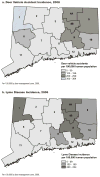The use of deer vehicle accidents as a proxy for measuring the degree of interaction between human and deer populations and its correlation with the incidence rate of Lyme disease
- PMID: 23621054
- PMCID: PMC3894613
The use of deer vehicle accidents as a proxy for measuring the degree of interaction between human and deer populations and its correlation with the incidence rate of Lyme disease
Abstract
The study described in this article examined the relationship between the incidence rate of deer vehicle accidents (DVAs), a proxy for measuring the interaction between populations of humans and deer, and human Lyme disease incidence rate. The authors also examined the relationship between deer population density and human Lyme incidence rate. They analyzed data from Connecticut's Department of Environmental Protection and the Department of Public Health from 1999 through 2008 by deer management zone (DMZ) and town. For DVA incidence rate versus Lyme incidence rate for both DMZs and towns, most of the correlation coefficients computed yearly were moderate to strong and all of the p-values were significant. A weak correlation was observed between deer population density and Lyme disease incidence rate by DMZ. The authors propose DVAs as a proxy for measuring the interaction between coexisting populations of humans and deer. The authors' study suggests that additional investigations of DVAs and their relationship to Lyme disease to further assess the utility of public health interventions are warranted.
Conflict of interest statement
None of the authors have a conflict of interest.
Figures
Similar articles
-
The relationship between deer density, tick abundance, and human cases of Lyme disease in a residential community.J Med Entomol. 2014 Jul;51(4):777-84. doi: 10.1603/me13232. J Med Entomol. 2014. PMID: 25118409
-
A review on the temporal pattern of deer-vehicle accidents: impact of seasonal, diurnal and lunar effects in cervids.Accid Anal Prev. 2014 May;66:168-81. doi: 10.1016/j.aap.2014.01.020. Epub 2014 Feb 2. Accid Anal Prev. 2014. PMID: 24549035 Review.
-
Evaluation of deer-targeted interventions on Lyme disease incidence in Connecticut.Public Health Rep. 2011 May-Jun;126(3):446-54. doi: 10.1177/003335491112600321. Public Health Rep. 2011. PMID: 21553675 Free PMC article. No abstract available.
-
Contrasting emergence of Lyme disease across ecosystems.Nat Commun. 2016 Jun 16;7:11882. doi: 10.1038/ncomms11882. Nat Commun. 2016. PMID: 27306947 Free PMC article.
-
Will Culling White-Tailed Deer Prevent Lyme Disease?Zoonoses Public Health. 2016 Aug;63(5):337-45. doi: 10.1111/zph.12245. Epub 2015 Dec 18. Zoonoses Public Health. 2016. PMID: 26684932 Free PMC article. Review.
Cited by
-
Target validation of highly conserved Amblyomma americanum tick saliva serine protease inhibitor 19.Ticks Tick Borne Dis. 2016 Apr;7(3):405-14. doi: 10.1016/j.ttbdis.2015.12.017. Epub 2015 Dec 29. Ticks Tick Borne Dis. 2016. PMID: 26746129 Free PMC article.
-
Lyme periprosthetic joint infection in total knee arthroplasty.Arthroplast Today. 2018 Jan 19;4(2):158-161. doi: 10.1016/j.artd.2017.12.003. eCollection 2018 Jun. Arthroplast Today. 2018. PMID: 29896545 Free PMC article.
-
Canine and human infection with Borrelia burgdorferi in the New York City metropolitan area.Parasit Vectors. 2018 Mar 20;11(1):187. doi: 10.1186/s13071-018-2774-z. Parasit Vectors. 2018. PMID: 29554949 Free PMC article.
-
The Association Between Hunter-Killed Deer and Lyme Disease in New Jersey, 2000-2014.Ecohealth. 2019 Jun;16(2):330-337. doi: 10.1007/s10393-019-01401-x. Epub 2019 Mar 1. Ecohealth. 2019. PMID: 30825021
References
-
- Bacon RM, Kugeler KJ, Mead PS Centers for Disease Control and Prevention. Surveillance for Lyme disease-—United States, 1992–2006. Morbidity and Mortality Weekly Report Surveillance Summaries. 2008;57(10):1–9. - PubMed
-
- Barbour AG, Fish D. The biological and social phenomenon of Lyme disease. Science. 1993;260(5114):1610–1616. - PubMed
-
- Burgdorfer W, Barbour AG, Hayes SF, Benach JL, Grunwaldt E, Davis JP. Lyme disease—a tick-borne spirochetosis? Science. 1982;216(4552):1317–1319. - PubMed
Publication types
MeSH terms
Grants and funding
LinkOut - more resources
Full Text Sources
Medical


